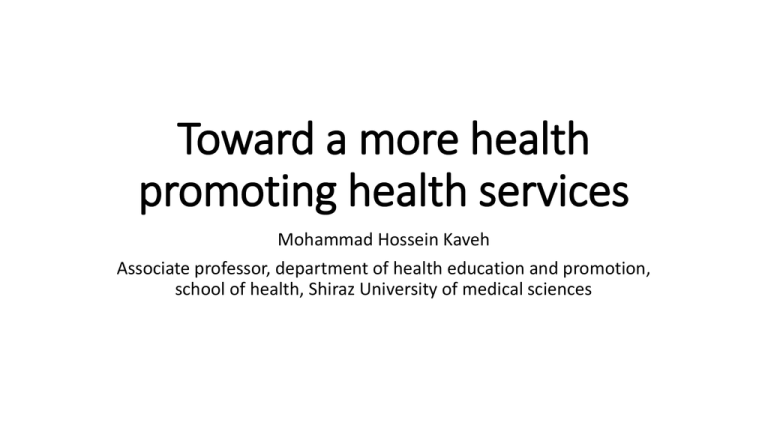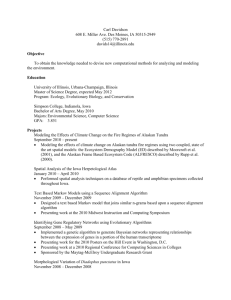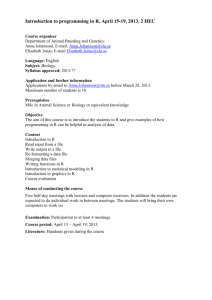Toward a more health promoting health services
advertisement

Toward a more health promoting health services Mohammad Hossein Kaveh Associate professor, department of health education and promotion, school of health, Shiraz University of medical sciences Introduction • The 1986 Ottawa Charter stressed reorienting health services to more health promotion as one of the five important developing action areas to more effectively contribute to population health. • However, international evaluations over the 20-25 years revealed that this part of the strategy had the least successful implementation. Introduction • The purpose of this paper is to reflect on why progress in this domain has been less than optimal in practice; possibilities and responsibilities for change, especially with regard to health (education/promotion) professionals’ roles, will be briefly discussed as well. Health systems are defined as: • . . . the ensemble of all public and private organizations, institutions and resources mandated to improve, maintain or restore health. • Health systems encompass both personal and population services, as well as activities to influence the policies and actions of other sectors to address the social, environmental and economic determinants of health. (WHO Regional Office for Europe, 2008) (ZIGLIO, SIMPSON, & TSOUROS, 2011) A well-functioning health system • not only ensures equitable and universal access to a good range of primary and preventive services but also advocates for better social and environmental conditions so as to enable people to increase control over, and to improve, their health. (ZIGLIO, SIMPSON, & TSOUROS, 2011) What do we mean by re-orienting health services? • It states that achieving improved population health outcomes will require an expansion in health promotion and disease prevention action to achieve an optimal balance between investments in health promotion, illness prevention, diagnostic, treatment, care and rehabilitation services in a health system. • Such an expanded role need not always be achieved through an increase in direct health system activity. (Wise & Nutbeam, 2007) the purposes of re-orienting health services • In short, the purposes of re-orienting health services as proposed in the Ottawa Charter were • to achieve a better balance in investment between prevention and treatment, and • to include a focus on population health outcomes alongside the focus on individual health outcomes. (Wise & Nutbeam, 2007; Johansson, Weinehall, & Emmelin, 2010). The need to reorient … • Nevertheless, the need to better balance investment among cure, care, prevention and health promotion is as important today as it was in 1986 (ZIGLIO, SIMPSON, & TSOUROS, 2011). • Current global health issues, including the economic crisis, climate change and a wide range of public health threats, pose both new challenges and new opportunities to reframe, reposition and renew efforts to strengthen health promotion and its role in re-orienting health services (ZIGLIO, SIMPSON, & TSOUROS, 2011). Make health systems part of the solution not part of the problem! • In today’s context, therefore, strengthening the promotion and protection of the health of individuals and communities as a core activity of health systems is not optional but a must. (ZIGLIO, SIMPSON, & TSOUROS, 2011) Acting on SDH • World-wide, the highest risk for the health of both individuals and communities is still social determinants, particularly poverty. • Evidence also indicates that life expectancy has been linked more to improved living conditions than to improved health care services. • Equally, the capacity of the health care sector to improve population health and health equity is strongly influenced by other sectors. • Health interventions including health promotion initiatives that overlook this fundamental issue may unintentionally increase health inequities. (ZIGLIO, SIMPSON, & TSOUROS, 2011) Functions of health systems • service delivery, • human and technological resource development, • financing and • stewardship (WHO Regional Office for Europe, 2008). • These functions cannot be effectively performed without a strong health promotion focus, particularly in light of today’s social and economic challenges (ZIGLIO, SIMPSON, & TSOUROS, 2011). Principles of health promotion • Health promotion: 1. involves the population as a whole in the context of their everyday life, rather than focusing on people at risk for specific diseases; 2. is directed towards action on the determinants or causes of health; 3. combines diverse, but complementary, methods or approaches; 4. aims particularly at effective and concrete public participation; and 5. health professionals, particularly in primary health care, have an important role in nurturing and enabling health promotion. (WHO, 2009) (ZIGLIO, SIMPSON, & TSOUROS, 2011). health promotion can help • Health promotion principles can help health systems better achieve their goals of improved health, responsiveness and financial fairness. • Health systems have better health outcomes when built on a primary health-care approach, with health promotion as a key element (WHO, 2008). (ZIGLIO, SIMPSON, & TSOUROS, 2011) • Such systems also have better potential for improving health equity, an important objective of health promotion. (ZIGLIO, SIMPSON, & TSOUROS, 2011) health promotion … • There is also a real risk that with health budgets coming under pressure and the growing burden of non-communicable diseases, that health promotion and preventive efforts will focus merely on lifestyle change and individual responsibility. • Efforts to mainstream or integrate health promotion within health systems must be undertaken in such a way that they are consistent with the principles of health promotion. • It also means implementing actions that include the five interdependent action domains of health promotion, e.g. action to create supportive environments that promote and protect health is just as important as educating people about healthy behaviours). (ZIGLIO, SIMPSON, & TSOUROS, 2011). Re-orienting health services; lethargic progress • However, it seems that this strategy has been the least systematically implemented. (Johansson, Weinehall, & Emmelin, 2010). • Across the world, the role and structure of health systems continues to be dominated by the provision of care for acute and chronic conditions. (Johansson, Weinehall, & Emmelin, 2010). • It is widely acknowledged that closing the implementation gap in health promotion by reframing, repositioning and renewing efforts to strengthen the health promotion role of health systems is still an unaccomplished agenda (ZIGLIO, SIMPSON, & TSOUROS, 2011). Evidence of lethargic progress towards … • the percentage of the health budget allocated to public and primary health efforts: • it is usually, 3–4% in many countries (IUHPE, 2000; Wanless, 2002). (ZIGLIO, SIMPSON, & TSOUROS, 2011) • only 5% (Johansson, Weinehall, & Emmelin, 2010) • As a consequence of a growing gap between demands and resources, health services today are becoming more and more overloaded. • Disease-oriented assignments have received greater funding whereas preventative measures have been cut down. (Johansson, Weinehall, & Emmelin, 2010) Evidence of lethargic progress towards … • There was still significant imbalance between treatment and care versus health promotion activities. (Johansson, Stenlund, Lundström, & Weinehall, 2010) • The past 200 years have seen a doubling of the human life span. Although enormous advances in biomedical interventions and health technologies have been made during that time, major inequities in health persist (Baum, Be´gin, Houweling, & Taylor, 2009). Evidence of lethargic progress towards … • Yet, countries’ investments in and through the health care sector are overwhelmingly confined to the provision of curative health services, especially hospital services, rather than being channeled to prevention and health promotion. • Moreover, when health promotion is incorporated at all, it is generally aimed at changing the behavior of individuals rather than creating wider physical, social, and economic environments supportive of healthy behavior. ( Baum, Be´gin, Houweling, & Taylor, 2009) Consequences • Inflations in health expenditures • In any case, an investment emphasis on new medical interventions tends to increase health inequities because interventions reach more advantaged groups before, if ever, trickling down. • In low- and middle-income countries in particular, socioeconomic inequalities translate into huge inequities in health care use. • approximately 150 million residents of countries with limited public sector health care have suffered financial catastrophe ( Baum, Be´gin, Houweling, & Taylor, 2009) a study by Zare et al (2014) in Iran • The results suggest heightened inequality in health care expenditures in Iran over the past three decades (1984-2010), including an increase in the gap between urban and rural areas. Furthermore, inflation has affected the poor more than the rich. Consequences • For example, the current emphasis of health systems investment in tertiary level curative and clinical services cannot be maintained. • Health systems that predominantly invest in tertiary and curative clinical services are becoming unaffordable in many countries and health promotion is an important vehicle to reorient investment so that health systems are not only more effective but also sustainable. (ZIGLIO, SIMPSON, & TSOUROS, 2011) Sustainabilty! • There is a growing consensus worldwide that our current patterns of health service development and expenditure are simply unsustainable. (EDITORIAL, 2014) • Growth in expenditure on health and aged care that outstrips growth in GDP will lead to worsening budget positions. • With the ageing of the world’s population and the rising impact of chronic diseases internationally most countries – both developed and developing – are experiencing similar challenges. (EDITORIAL, 2014) Challenges/barriers • within our own field of health promotion we often focus on making the case for action on the social determinants. • So much so that we often downplay the role and contribution that health systems can make; and • the field of health systems and related policy development is still dominated by the provision of tertiary services and often those who work at this level—be it developing new clinical interventions or providing them (ZIGLIO, SIMPSON, & TSOUROS, 2011). Challenges/barriers • The health care sector is clearly dominated by a biomedical imagination. • In such a worldview, curative medicine is privileged over strategies that emphasize disease prevention and health promotion. ( Baum, Be´gin, Houweling, & Taylor, 2009) • Challenges/barriers • leadership • Management (Johansson, Stenlund, Lundström, & Weinehall, 2010). Challenges/barriers • However, along with recent socio-economic developments and scientific and technological progress, medical disciplines have become more and more specialized, and clinical and preventive medicine have become further separated from each other. • Humanism in medical practice is getting lost. ( Li, Tang, Lv, Jiang, & Griffiths, 2011) Challenges/barriers • Medical education is largely built on the biomedical model of diseases. • However, the biomedical model has shown some obvious limitations. • In this model, an individual is simply taken as a machine. • Doctors treat symptoms rather than the disease; • they treat the disease rather than the person. ( Li, Tang, Lv, Jiang, & Griffiths, 2011) Challenges/barriers • …, the biomedical model is unable to satisfactorily explain and effectively deal with many of the challenges we are facing, such as human immunodeficiency virus/acquired immunodeficiency syndrome, drug abuse, alcoholism and depression. • Smoking, physical inactivity and unhealthy diet are all influenced by the environment in which we live. ( Li, Tang, Lv, Jiang, & Griffiths, 2011) Challenges/barriers • escalating health care costs to come with the growing burden of chronic disease in poor countries—raise the question of the sustainability of the biomedical model. ( Baum, Be´gin, Houweling, & Taylor, 2009) The biopsychosocial model • The biopsychosocial model emphasizes that there are many other important determinants of health that have not been given sufficient attention, such as natural and social environments, education and employment, and organization and delivery of healthcare systems. ( Baum, Be´gin, Houweling, & Taylor, 2009) Challenges/barriers • We believe that part of the answer lies in the lack of integration, active advocacy and leadership from health promotion within health systems. • The profession of health promotion has too often separated itself and been separated from mainstream health systems. (ZIGLIO, SIMPSON, & TSOUROS, 2011) Challenges/barriers • Growing Privatization • In this environment, health budgets are devoted overwhelmingly to hospitals, medical and pharmaceutical services, and biomedical research, and budget incentives encourage patient throughput rather than health outcomes. ( Baum, Be´gin, Houweling, & Taylor, 2009) Challenges/barriers • Research-Supported Interventions • …., funding for intervention research on social determinants of health is negligible relative to funding for biomedical science research. ( Baum, Be´gin, Houweling, & Taylor, 2009) a multifaceted and complex process • The implementation of a more health-oriented health service is a multifaceted and complex process. • It requires changes in professional behaviors and working methods as well as changes in organizational cultures and structures (Johansson, Stenlund, Lundström, & Weinehall, 2010). • The outcome depends on the interaction among: • the innovation itself, • the intended adopters, and • the context (Johansson, Stenlund, Lundström, & Weinehall, 2010). The intended adopters (the health professionals) • health professional’s own values, norms, and perceived needs, will or desire to act, sense of ownership and autonomy with regard to one’s work are important motivational factors (Johansson, Weinehall, & Emmelin, 2010) • Other important factors: • • • • Organizational commitment: Job Involvement: Psychological Empowerment: Perceived Organizational Support (POS): (Robins and Judge, 2009) • These factors are largely determined by the characteristics of the organization (Johansson, Weinehall, & Emmelin, 2010). The intended adopters (the health professionals) • lack of time/heavy workload • Lack of guidelines and unclear objectives • lack of competence; • physicians need more skills in health promotion interventions, lifestyle counseling, empowering communication, and in the task of motivation (Johansson, Stenlund, Lundström, & Weinehall, 2010). the context (Organizational structures) • Organizational structures that provide resources, support and the opportunity to learn and develop are empowering and enable employees to accomplish their work. • directives from “above” do not always get a friendly reception opportunities for • There are ample opportunities for health systems to advocate, enable and mediate for health, to change policies, legislation and practices to create and ensure more equitable health-promoting environments in which people play, learn, work and age. • Health services, however, should also be exemplar of the change they advocate for and put their own house in order (WHO Regional Office for Europe, 2010a). (ZIGLIO, SIMPSON, & TSOUROS, 2011) The final word • Reforms in health curriculums; • outcome-based and community-based curriculum • Health promotion oriented • Reorienting health researches • Adopting a team-based interdisciplinary approach (involving health promotion professionals) • Planning strategically for continuous professional development of human resources •Thank you





